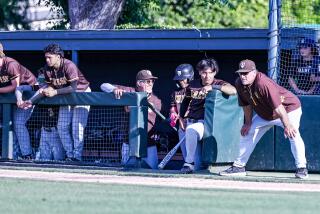Mission Belles
- Share via
Six generations of Avila women have slept in the elegant four-poster bed. The first was Rosa Avila after her wedding in 1865 to Pablo Pryor at Mission San Juan Capistrano.
Hand-carved of rosewood and dressed with hand-embroidered linens, the bed was a bridal gift from Avila’s father, San Juan Capistrano landowner Don Juan Avila. The treasured antique has been handed down through the years from daughter to daughter.
It now rests--temporarily--in the Rancho Room of the mission as part of the museum’s millennium exhibit, “Celebrating Cultural Connections,” through Dec. 31.
The first major exhibit to be unveiled in 10 years, it paints an intimate and compelling portrait of home life in 19th and early 20th century Orange County. It’s a picture made all the more vivid as each piece reveals a personal story, a family tradition or a centuries-old tie to the mission.
History permeates the long, narrow Rancho Room. One corner is stacked with vintage leather, wood and metal steamer trunks from Asia and Mexico. The trunks were unearthed two years ago in the mission’s basement, then cleaned and waxed by volunteer members of its Arts & Artifacts Council.
A plain wooden soldier’s trunk dates to the 1790s, when men lived in barracks at the mission; a turn-of-the-century black leather-bound trunk was discovered to be the property of the mission’s pastor in 1910, Father John O’Sullivan.
“These trunks were like the Sears & Roebuck of luggage for people traveling by stagecoach, ship or train,” said museum Programs Director Alana Jolley. “They were also the closets of the day--once people reached their destination, they still kept everything in them.”
Along with the trunks, the exhibit has set up vignettes that include a cozy parlor scene and a partial re-creation of Rosa Avila’s bedroom.
“The parlor was where life’s important moments were shared with family and friends,” Jolley said. “Since marriages here at that time connected both families and cultures, we set the scene for a celebration, ready to welcome the bride and groom with flowers and music.”
The engraved silver tea service was used at Rosa Avila’s wedding; it sits on a 200-year-old Spanish table found on the mission grounds and restored by the artifacts council.
The parlor also houses a grand piano of rosewood that once graced the home of Juan Forster and his family, who lived on the mission grounds in the 1860s. The piece is on loan from San Juan Capistrano resident Tony Forster.
Across the room, a marble-topped dresser with an oval tilt mirror sits next to Rosa Avila’s four-poster bed. On it, rests a wooden apothecary box, where she kept her medicines; two pink-painted china perfume bottles; and a water carafe belonging to her husband, Pablo.
“The pieces have never been separated,” said Avila’s great-granddaughter, Sallie Plaskoff.
Plaskoff, who lives in Beverly Hills, speaks fondly of her family’s tradition, where four sets of grandmothers and granddaughters have slept in the bed.
“My mom slept in there with her grandmother, Rosa, when she was a little girl. I slept in it with mine, and my daughter with hers. I slept in the bed with my granddaughter Lauren,” Plaskoff said, adding, “It’s something that I really miss now that we’ve loaned the bed to the museum for the duration of the exhibit.
“It’s a special feeling to lie in the bed and realize how many generations have come and gone. My mom always told me to be proud of our heritage; these things are an extension of that lifetime.”
Before closing the Rancho Room exhibit for the day, Jolley gazes at the collection of family heirlooms one last time.
“This is living history at its best. These are all things that people really used, and they give us an understanding of how they lived.
“These items have lasted generations because people really appreciated and took care of what they had.”
(BEGIN TEXT OF INFOBOX / INFOGRAPHIC)
What’s on Display
Here are the decorative artifacts on exhibit at Mission San Juan Capistrano.
Furniture
* Four-poster wedding bed of Rosa Avila and Pablo Pryor.
* Marble-topped dresser.
* Pre-Eastlake style settee, circa 1860.
* Eastlake-style hall tree, late 1800s.
* Rosewood grand piano, made in New York and shipped via Cape Horn for the Forster family home.
* 1867 ledger desk belonging to Marco Forster.
* Cases filled with everyday items, including eyeglasses, lady’s compact, darner and religious objects.
Furnishings
* Oval-framed pictures of Marcos and Guadalupe Forster.
* Silver from the Pryor wedding in 1865, American-made from Philadelphia.
* Hand-drawn and -painted California coastal maps, 1851-1856. Made by U.S. survey team after California became a state in 1850.
* Leather, wood and metal trunks, from Asia and Mexico, mostly circa 1830s-1850s.
If You Go
The “Celebrating Cultural Connections” exhibit runs through Dec. 31 at Mission San Juan Capistrano, at Ortega Highway and Camino Capistrano in San Juan Capistrano. Exhibit is open from 10 a.m. to 4 p.m. daily. Mission hours are 8:30 a.m. to 5 p.m. (949) 234-1300.
The Arts & Artifacts Council sponsors an historical lecture at the mission at 9 a.m. Sept. 30. Speakers are garden editor Lucy Warren (“Gardens That Nourish--Kitchen Gardens Through History”) and Pat Hammer (“Topiary: A World of Whimsy”). $15. For information, call Mozelle Suket, (949) 240-6576.
More to Read
Sign up for Essential California
The most important California stories and recommendations in your inbox every morning.
You may occasionally receive promotional content from the Los Angeles Times.













